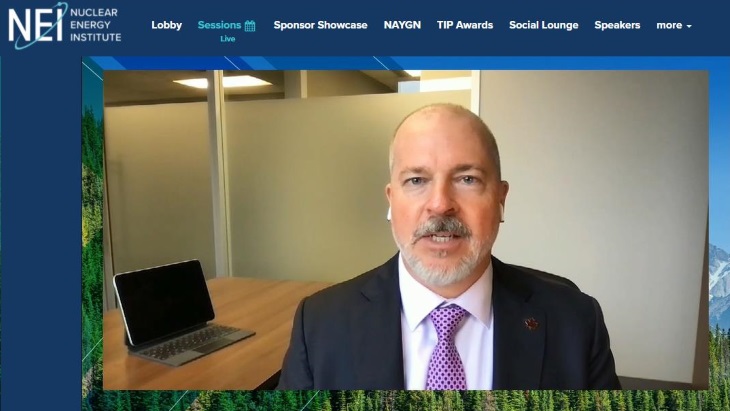Renewables need nuclear to be effective, says Gorman
10 June 2021
Solar and wind power have the same share of low-carbon electricity globally that they did 20 years ago, proving that they need to work together with nuclear energy for net zero to be achievable, John Gorman, president & CEO of the Canadian Nuclear Association (CNA), told delegates at the Nuclear Energy Assembly yesterday. Gorman was speaking in the panel discussion Nuclear Energy: A Tool for Meeting Global Goals at the US Nuclear Energy Institute (NEI) event. The panel was moderated by Carol Berrigan, NEI's executive director for Federal Programs and Supplier Relationships.
 John Gorman, president & CEO of the Canadian Nuclear Association, speaking at the Nuclear Energy Assembly
John Gorman, president & CEO of the Canadian Nuclear Association, speaking at the Nuclear Energy Assembly
Before joining CNA, Gorman was the president & CEO of the Canadian Solar Industries Association (CanSIA). In July last year, CanSIA and the Canadian Wind Energy Association (CanWEA) united within the Canadian Renewable Energy Association to form one voice for wind energy, solar energy and energy storage.
"I shifted over to nuclear because of this growing recognition that we're not making progress quickly enough as a world, in terms of decarbonising our electricity grids," Gorman said. "Twenty years ago, when I started in the renewables business we had 36% non-emitting electricity on the world's grids. Today, 20 years later, we're still at 36%, and that's despite the very low cost wind and solar we have available now and the very high amount of investment and high penetration that we're seeing globally of renewables."
The natural ally for renewables is nuclear, he said.
"It's clear that we're going to need a partner for renewables that is not gas or coal-fired electricity generation, and hence the importance of keeping our nuclear fleet online globally, and building much-needed new nuclear, whether it's conventional large plants or small modular reactors.
"In the Canadian context, I believe we're doing just about everything right, if I may say, from a nuclear perspective. We're refurbishing the majority of our nuclear units, which supply about 15% of our nation's electricity. We are positioned to be a first-mover in small modular reactors. We've got a very healthy nuclear eco-system because of the large refurbishments that are going on, and it's enabling all sorts of innovation, not only in power and heat-related activities, but also in medical science and related issues. We've got some terrific collaborations going on with international bodies like the NEI and looking at the challenges and new innovations ahead. So I think we're doing a lot of things right here in Canada and we're looking forward to Canada achieving its climate target but helping other nations do the same in partnership with other important nuclear nations around the world."
Berrigan asked what makes him optimistic about the future of nuclear, and what he would like to see as having been achieved by 2035.
"I'm sensing growing global recognition for nuclear as needed for a net-zero future," Gorman said. "And we're beginning to see those policy changes, we're beginning to see stakeholders of all sorts who formerly dismissed nuclear now revisiting nuclear and trying to understand its role in decarbonsing our economies as we go forward to a net-zero future.
"I see the excitement that is accompanying small modular reactors and the way that's it's allowing us to enter into places where nuclear was not discussed before, and the particular attributes of nuclear, especially the high-temperature, clean heat and the responsiveness and flexibility of these scalable new technologies to be a really important partner for wind and solar, intermittent sources.
"All of these things make me very optimistic, but I would also say there is an almost inevitability to the growing role of nuclear. There's a growing realisation that we are simply not making progress enough with the existing suite of 'favoured' technologies that are on the table. As needed and important as solar and wind and storage are, we are going to need massive amounts of new clean electricity generation two to three times what we've got now globally to tackle this challenge, and nuclear is really the only technology that has proven its ability to do really large-scale decarbonisations of economies. And the new technologies that we're seeing with SMRs have such important potential in terms of these other areas of supporting renewables and bringing clean heat to the table. So, I'm very optimistic and in fact it's inevitable."
On what he would like to see happening by 2035, he said that, in the Canadian context, he hopes SMRs will be rolled out in the hard to decarbonise parts of the country's economy and that it will be positioned to use those technologies to help other nations decarbonise, too.
He stressed the importance of US-Canadian collaboration on creating harmonised regulatory and licensing frameworks, which will "enable us to roll out these new technologies very efficiently to help other nations". He added: "I hope that will have proved itself by 2035."
Researched and written by World Nuclear News